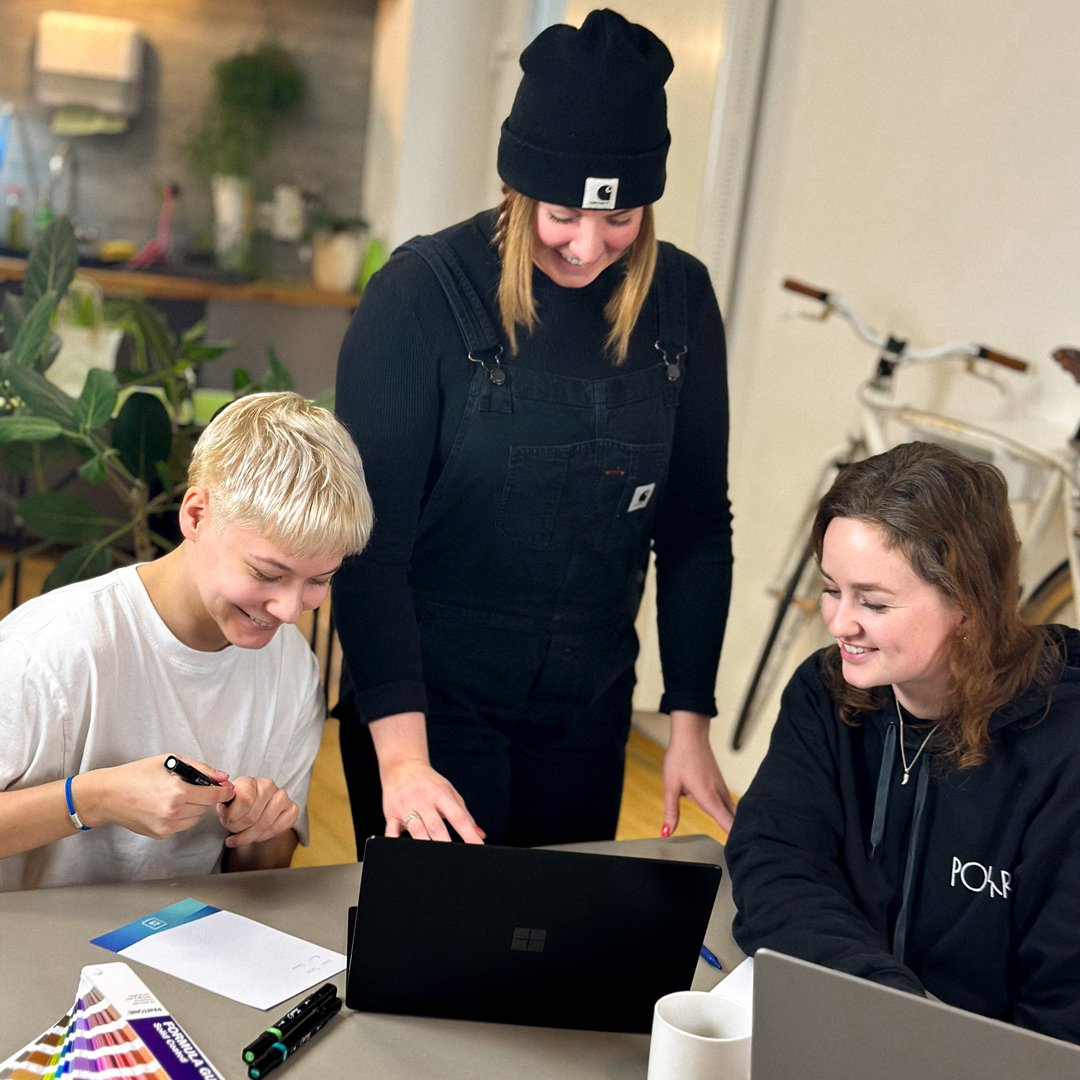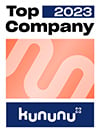UX design for software applications: What you need to consider - an interview with our graphic designer

You may have heard of user experience design, or UX design for short. In the digital sector, it plays a crucial role for users and the success of your digital product or your digital presence. In this article, we would like to take a closer look at UX design and, above all, find out why it must also be taken into account when developing the user interface of your software. That's why we've asked the most important and interesting questions about UX design in software applications to our graphic designer Leonie, who will reveal the most useful information and helpful tips that will help you create a prototype and ultimately the right software. Stay tuned if you want to find out more now!
Reading time 5 min
- A brief overview: What is UX design?
- And what was the difference between UI and UX design again?
- UX design and software
- An interview with our graphic designer Leonie
- Our conclusion
- FAQ
A brief overview: What is UX design?
UX design or user experience design deals with the combination of good functionality, appealing and intuitive design as well as reliable usability and accessibility of a digital product. It is used, for example, to make websites as user-friendly as possible. The focus is on the user experience and the feeling it creates.
And what was the difference between UI and UX design again?
They can be considered separately. However, there is a crucial difference between the two terms. User interface design, or UI design for short, is about the visual design of an interactive application. The look and feel are relevant for user interface design. In UX design, the focus is on the feeling during use, i.e. the overall user experience. Of course, the look, i.e. UI design, also plays a role here, but so do many other aspects such as good functionality.
UX design and software
UX design is not only an important part of websites, but also takes place in software applications. Find out exactly what this looks like, what you need to consider and why UX design is so important for software in the interview with our graphic designer Leonie.
An interview with our graphic designer Leonie
Leonie studied communication design at Dortmund University of Applied Sciences and Arts and specializes in UX & UI design. In her private life, her heart beats for interior design and skateboarding. We sat down with Leonie and asked her the most exciting questions about UX design in software applications. Of course, we don't want to withhold Leonie's answers from you!

Meike:
Software doesn't just have to work technically flawlessly, it also has to be a positive experience for the user. Leonie, can you explain a little about how UX design is used in software?
Leonie:
UX design actually encompasses the whole user experience when using the software application. That's why it's also called UX, or user experience.
On the one hand, this includes the user interface, including the visual design, layout, navigation, interaction elements and information architecture, but also the efficient and effective use of the application. However, aspects such as requirements analysis, user research, prototype development/wireframing, usability tests and the continuous improvement of the user experience are also important.
Meike:
Why is UX design important for software? Do you think that software can still be successful today without UX design?
Leonie:
Without proper UX design, software would be very frustrating for users. They would not want to use the application. This could result in customers dropping out and leaving the application.
However, good UX design helps to create a positive user experience. Good UX design practice takes into account the needs and requirements of users to enable simple, intuitive and efficient interaction with the software. This increases user satisfaction and loyalty, improves efficiency and effectiveness when using the software, reduces the error rate and ultimately promotes business success through higher user acceptance and loyalty. Good UX design can therefore help to ensure that a product or service is better tailored to the needs and expectations of users and is therefore positioned more successfully on the market. It is therefore essential that UX design is taken into account when developing software.
Meike:
Okay, we now know that UX design is indispensable for good software applications. However, you also have to take the respective target groups into account, don't you? How can the target group be taken into account in the UX design process? Can you also give us a brief insight here?
Leonie:
The target group plays an essential role in UX design. Without a precise target group, graphic artists and designers cannot create a target group-oriented design. In order to understand user needs and requirements, it is important to know the target group of the product or service. This can be achieved through a target group analysis in which data such as demographics, behaviors, goals, motivations and challenges of the users are collected and analyzed. A good UX design always considers the target group and their needs in order to create a positive user experience. Just imagine you want your grandma to use your latest smartphone to call her grandson. Not that easy. That's why "grandparent smartphones" were developed for this use case: Larger buttons, short explanations, no bells and whistles. - The "grandparents" target group can operate the device more easily and successfully. Software applications have to be adapted to the design of each target group so that they are perfectly tailored to them.
Meike:
In the field of coding and software development, there are always structures and rules that are used to achieve good and quick results. Is there anything like this in the field of UX design? If so, what are the rules for good UX design?
Leonie:
There are several rules in UX design. These include user-friendliness, accessibility, effectiveness, efficiency and aesthetics.
Usability is essential for good UX design. The software must be easy to use and enable users to achieve their goals quickly and easily. They should understand the application intuitively and the navigation should be logical and efficient. A clear user interface, which is also attractively designed, should be integrated.
Accessibility is a must when developing the design. Software applications should be accessible to all users, including people with disabilities (e.g. color blindness).
Effectiveness plays a crucial role so that users do not drop out before reaching their and your goal. You need to enable users to complete their tasks effectively. The UX designer must ensure that the application meets the users' needs and provides them with the tools and functions they need to complete their tasks. Efficiency also plays into this. You need to help users save time and complete their tasks faster. If the application is efficient, users need to invest as little time as possible to achieve their goals.
Last but not least, aesthetics are also crucial. An aesthetically pleasing design appeals to users and gives them a positive feeling. This makes it more likely that they will use the software again.
Meike:
I'm sure you also work with some tools on a daily basis. Are there any design tools for UX design that can also be used when developing software applications?
Leonie:
I find Adobe XD or Figma to be a great help. The applications are similar and each has its own fans. Personally, I prefer to use the Adobe XD design tool. This is an application with which you can design user interfaces - for every possible use, whether website, app or software application and more. Once the design has been created here, you can test it optimally. You can also present initial drafts to the customer and then forward them directly to the developers for implementation.
Meike:
Now that the importance of UX design in software development has been made clear by the last questions, I am interested in the following: How does a software design process usually work for you? Can you give us a little insight here?
Leonie:
As a rule, the software design process is always the same. The most important thing for us is always research. We have to take a closer look at the topic and the target group, collect and collate information. In principle, we need to know everything about the users, their needs, their requirements and their expectations. Important tools here include interviews, surveys, observations and other research methods. Then we move on to planning. This is where the goals of the application are defined. This also includes the timeframe for implementation. This is followed by concept development. Here we like to work together as a team. With other creative minds, it is always easier to understand the target group's problem and find good solutions. This also includes working out the definition of the information architecture, navigation and interaction options. In this step, the first wireframes and prototypes are often created in Adobe XD to make the project easier to grasp. But pen and paper also work well. Now comes the so-called iterative design. Several iterations of the design are carried out. This includes creating UI designs and iterating on feedback from users and stakeholders. In the best case scenario, this continues until we and the customer are satisfied.
This is followed by the final implementation of the design. For me, this step also takes place in Adobe XD. Once the implementation of the design is complete, we usually present it to the customer so that the application can then be finally programmed. Of course, even after the launch, it is important to respond to user feedback and interactions in order to continuously improve the design and better engage with users.
Meike:
If I am now further interested in the field of UX design or would like to take another look at a summary of the most important terms, can you recommend a video?
Leonie:
To get some good basic information, you can always have a look at YouTube. The following video is a good example:
Thank you Leonie for your time, the interesting input and the helpful tips!
Our conclusion
Through the interview with Leonie, you have learned that UX design is indispensable for the development of software. It is important that you respond to your users and involve them in every step. That's why you should take time to conceptualize and create the user experience design and think through this part of the software creation process. As we've heard, target group analysis can be crucial to the success of your software. We are happy to help you with the UX design of your software. As you can see, Leonie and our team are experts in this field. We can support you from start to finish and offer you technical support and assistance even after your software goes live. Feel free to contact us for a no-obligation consultation and we will explain our range of services and how we can be at your side, tailored to your individual needs!
FAQ: More questions and answers about UX design
We have already asked Leonie the most important questions. She helped us to better understand UX design in combination with software. Now you know how important user experience design really is and that you shouldn't miss out on studying this topic in depth. If you would like to know even more, the following questions may be a starting point for you to learn more about UX design. You may also be unclear about a few terms that we would like to briefly explain to you now.
-
What is wireframing?
A wireframe refers to the structural design of a digital product such as software. Wireframing should answer the questions "what?", "how?" and "where?". In the best case, the model of a software therefore contains all the information about the presentation of the individual elements. It should also contain information about the navigation of the software.
-
What is Balsamiq?
Balsamiq or Balsamiq Studios is a tool for creating web-based mockups. You can either install it directly on your desktop or use it from the cloud to develop mockups and wireframes. The tool is particularly suitable for beginners as it is quick and easy to use. There are ready-made elements that you can simply drag and drop into your design.
-
What is the difference between Adobe XD and Figma?
Adobe XD and Figma are both tools that you can use for prototyping and designing. However, they do not work in exactly the same way and each has advantages and disadvantages. We don't want to recommend a specific tool here, but think that you should form your own opinion. This is the best way to find out what suits you best. Our graphic designer Leonie, for example, simply gets on better with Adobe XD. Here you have reusable elements that you can also edit. You can scale objects responsively, have cloud storage functions and can also easily export all designs. If you have already worked with other Adobe products, you will probably get along well with Adobe XD. Figma is also cloud-based and contains a large library of extensions that can be used for designing. It is perfect for collaborative work in particular. You don't even need to export or import files to share them.
-
When is UX design used in the development process?
UX design is used in various phases of the development process. It is a success factor for the development of user-friendly and intuitive products and plays an important role in the design of user guidance. The first step in UX design is to gather knowledge about the target group and their needs. This is typically done using user research methods such as interviews, surveys and user tests. The insights gained serve as the basis for creating a user-centered design, and the priority of UX design is to optimize the user experience and ensure that the product meets the needs of the users. It is about improving usability, accessibility and efficiency, and the implementation of UX design is usually done in close collaboration with the developers. The UX team creates wireframes, prototypes and design specifications to define the interactions and appearance of the product. The developers use this information to translate the UX design into the actual development of the product.
-
Does UX design always need to be optimized for a website, for example?
Yes, UX design should always be optimized on a website to ensure the best possible user experience. A website is an interactive medium that is constantly being used by users. Therefore, it is important that the UX design is continuously tuned and improved, and by regularly optimizing the UX design, considerations can be made as to how the website can become more valuable to users. This can mean, for example, simplifying navigation, presenting content in a better structured way or optimizing loading times. By continuously reviewing and adapting the UX design, potential friction points can be identified and eliminated to ensure the smoothest possible user experience In addition to purely functional optimization, aesthetic and emotional factors also play a role. An appealing visual design and a positive emotional experience help to ensure that users perceive the website as pleasant and valuable, and users' needs and requirements also change over time. New technologies, trends and user behavior can lead to changes that require adjustments to UX design. By staying up to date and continuously optimizing the UX design, you can ensure that the website always remains relevant and user-friendly for users.
Was ist dein Projekt? Wenn du uns darüber erzählen möchtest, rufen wir dich zurück!

Hello, my name is Meike. I take care of the EXWE back office and am responsible for our social media channels. All of our articles are meant to make your life easier and help you make decisions. Nevertheless, it can happen that something remains unclear, so: If you have questions about this article you can easily reach me at +49 231 93149827.
Learn how to create a successful Shopify store step by step and launch your own online shop with confidence. Our comprehensive guide walks you through the process, empowering you to build a thriving e-commerce business from scratch.
Learn effective Shopify marketing strategies for more sales in your online store in our article. Discover how to increase your reach, boost customer loyalty and optimize conversions to unlock the full potential of your e-commerce business.
Shopware 6 order confirmation tuning: 10 tips for optimizing the order confirmation email






